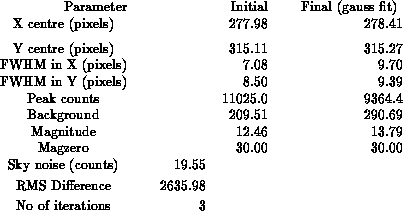




Previous: MOVESTAR - Put an object onto a specified area of the chip
Up: LEXIDATA DISPLAY OPERATIONS
Next: The Lexidata Joystick and switches
Previous Page: MOVESTAR - Put an object onto a specified area of the chip
Next Page: The Lexidata Joystick and switches
The prime purpose of this program is to do gaussian fits to stellar images
to provide estimates of FWHM etc.
Of course the stellar images are not gaussian but the program was initially
conceived as a way of providing a faster and more objective method of finding
the best telescope focus after a focus run. The advantage of the fitting
program is that all the data in the image is used to estimate the FWHM
not just the particular row or column you happened to select with the Lexidata
cursor. In practice the improvement over PHOTOM is not great so it is intended
to provide a specialised version of PHOTOM for use with focus run images.
The program is perhaps the most useful as a means of doing two PHOTOM profiles
and STATS in one operation.
To invoke the program type STARFIT - the program works similarly to PHOTOM
in many respects, being operated exclusively by the Lexidata switches and
joystick. The various switches are described below.
EXIT - depressing this simply exits from the program
RESET - clears the overlays and resets the program to its starting
condition.
UP - each time this switch is depressed the Lexidata cursor increases
in size by 2 pixels.
DOWN - the opposite of UP, it decreases the Lexidata cursor by 2 pixels.
READ - Reads the current cursor position and performs an operation that
depends on the currently selected MODE.
MODE - Each time this switch is depressed the program switches to a new
mode of operation. There are five modes in all as described below.
- LIST - Identical to LIST in PHOTOM i.e. it outputs a 9 x 9 array of
pixel values centered on the currently read cursor position.
- STATS - Performs a fully 2-D linearised least squares gaussian fit to
the section of the image enclosed by the Lexidata cursor box. The output
to the terminal is shown attached. The initial estimates are just those
you would get with PHOTOM if you did profiles in
 and
and  through the
peak pixel values within the box. Similarly the background, magnitude and
sky noise are those you would get if you used the STATS option in PHOTOM.
through the
peak pixel values within the box. Similarly the background, magnitude and
sky noise are those you would get if you used the STATS option in PHOTOM.
The size of the RMS difference in relation to the sky noise gives an
indication of how good the fit is.
- PROFILE - This is the default mode. It is identical to STATS as described
above but in addition after doing the fit, plots the best fit gaussian and
the data along the axes through the peak pixel in the selected area.
- REMOVE - Does STATS as described above but in addition after doing the
fit, plots the best fit gaussian and redisplays the resultant image.
- CLEAN - Similar to REMOVE but after doing the fit to the selected object
it uses default FWHM rather than the fitted FWHM at that position when
subtracting off the gaussian. The default values are picked up from the
last gaussian fitted by STATS, PROFILE or REMOVE. This enables you to subtract
off a standard shaped gaussian from any position.
There are a further three points which should be noted.
- Both CLEAN and REMOVE are disabled if the file is protected i.e. you
cannot accidentally modify a run that has not been dumped to tape.
- REMOVE and CLEAN modify the image on the disk if it is not proteceted.
If you want to use this option and keep an unmodified version on disk then
you should make a copy of the image, display the copy and then do STARFIT
on it.
- Consective reads of the same position will bypass the gaussian fitting
and just carry out the operations specific to the currently selected mode.
Example
Point No 1 ~ ~ Pixel coords 279, 314 ~ ~ Counts = 8416






Previous: MOVESTAR - Put an object onto a specified area of the chip
Up: LEXIDATA DISPLAY OPERATIONS
Next: The Lexidata Joystick and switches
Previous Page: MOVESTAR - Put an object onto a specified area of the chip
Next Page: The Lexidata Joystick and switches





 and
and  through the
peak pixel values within the box. Similarly the background, magnitude and
sky noise are those you would get if you used the STATS option in PHOTOM.
through the
peak pixel values within the box. Similarly the background, magnitude and
sky noise are those you would get if you used the STATS option in PHOTOM.
